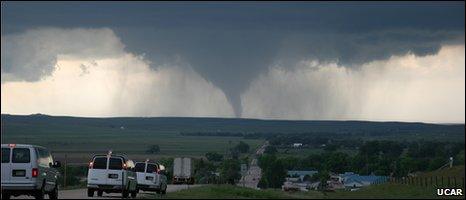Researchers embark on 'unprecedented' tornado study
- Published

Researchers hope the study will help improve tornado warnings and forecasts
An international team of researchers is embarking on what has been described as the most ambitious tornado study in history.
An array of instruments will be deployed across the US Great Plains, where violent twisters are more common than anywhere else on the planet.
It is hoped that the data gathered will improve tornado warnings and forecasts.
More than 100 scientists will be involved in the study, which will continue until the middle of June.
"Tornadoes rank among the most destructive weather events on Earth," said Dr David Dowell, one of the project's principal investigators and a scientist for the US National Center for Atmospheric Research (NCAR).
"It is imperative that we learn more about how they develop and why some are so powerful."
The study, Vortex2, will use a range of enhanced mobile radars and other weather-sensing equipment in order to build up a comprehensive picture of the zones where tornadoes develop.
Researchers say that rapidly changing contrasts in wind and temperatures in an area just a few miles across can spawn a tornado in a matter of minutes.
But, they added, only a small percentage of "supercell storms" generate twisters, and standard observing networks and radars struggle to pick up the atmospheric conditions that lead to the formation of a tornado.
On the road
The radar fleet for the field project includes 10 mobile radars, which will track winds and precipitation in the tornadoes and the surrounding area.
The team will also be using more than 36 portable surface weather stations, weather balloons, and they hope to send an unmanned 12ft aircraft to the edge of severe storms to collect data.
The study area stretches from West Texas to south-west Minnesota, covering more than 900 miles (1,450km).
The researchers will not have a fixed base, spending the entire six weeks on the road following outbreaks of severe weather.
The project will build on the findings from the original Vortex study, which was conducted in 1994-95 and gathered data on supercells - long-lived thunderstorms that can spawn tornadoes.
The $12m (£8m) project is primarily funded by the US National Science Foundation, and will include researchers from Europe, Canada and Australia.